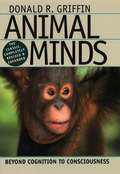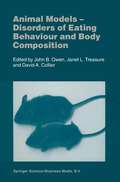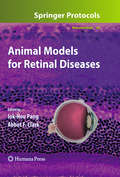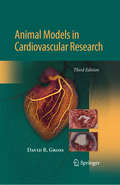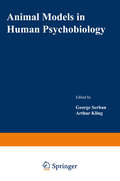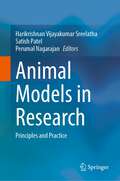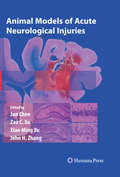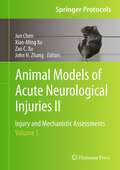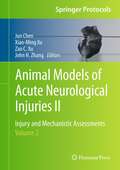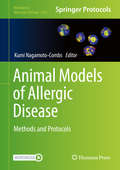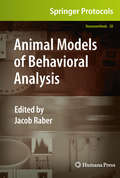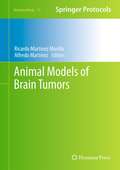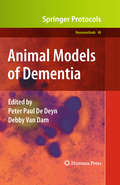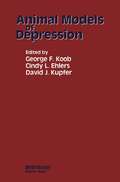- Table View
- List View
Animal Minds: Beyond Cognition to Consciousness
by Donald R. GriffinIn Animal Minds, Donald R. Griffin takes us on a guided tour of the recent explosion of scientific research on animal mentality. Are animals consciously aware of anything, or are they merely living machines, incapable of conscious thoughts or emotional feelings? How can we tell? Such questions have long fascinated Griffin, who has been a pioneer at the forefront of research in animal cognition for decades, and is recognized as one of the leading behavioral ecologists of the twentieth century. With this new edition of his classic book, which he has completely revised and updated, Griffin moves beyond considerations of animal cognition to argue that scientists can and should investigate questions of animal consciousness. Using examples from studies of species ranging from chimpanzees and dolphins to birds and honeybees, he demonstrates how communication among animals can serve as a "window" into what animals think and feel, just as human speech and nonverbal communication tell us most of what we know about the thoughts and feelings of other people. Even when they don't communicate about it, animals respond with sometimes surprising versatility to new situations for which neither their genes nor their previous experiences have prepared them, and Griffin discusses what these behaviors can tell us about animal minds. He also reviews the latest research in cognitive neuroscience, which has revealed startling similarities in the neural mechanisms underlying brain functioning in both humans and other animals. Finally, in four chapters greatly expanded for this edition, Griffin considers the latest scientific research on animal consciousness, pro and con, and explores its profound philosophical and ethical implications.
Animal Minds: Beyond Cognition to Consciousness
by Donald R. GriffinIn Animal Minds, Donald R. Griffin takes us on a guided tour of the recent explosion of scientific research on animal mentality. Are animals consciously aware of anything, or are they merely living machines, incapable of conscious thoughts or emotional feelings? How can we tell? Such questions have long fascinated Griffin, who has been a pioneer at the forefront of research in animal cognition for decades, and is recognized as one of the leading behavioral ecologists of the twentieth century. With this new edition of his classic book, which he has completely revised and updated, Griffin moves beyond considerations of animal cognition to argue that scientists can and should investigate questions of animal consciousness. Using examples from studies of species ranging from chimpanzees and dolphins to birds and honeybees, he demonstrates how communication among animals can serve as a "window" into what animals think and feel, just as human speech and nonverbal communication tell us most of what we know about the thoughts and feelings of other people. Even when they don't communicate about it, animals respond with sometimes surprising versatility to new situations for which neither their genes nor their previous experiences have prepared them, and Griffin discusses what these behaviors can tell us about animal minds. He also reviews the latest research in cognitive neuroscience, which has revealed startling similarities in the neural mechanisms underlying brain functioning in both humans and other animals. Finally, in four chapters greatly expanded for this edition, Griffin considers the latest scientific research on animal consciousness, pro and con, and explores its profound philosophical and ethical implications.
Animal Models: Disorders of Eating Behaviour and Body Composition
by David A. Collier Janet L. Treasure John B. OwenThe book aims to review knowledge on the disorders of eating behaviour and body composition in some of the non-primate higher animals and to relate these to similar conditions in humans. With advances in understanding the nature of these disorders and their biological basis, it seems timely to assess what cross-species comparisons can tell us about the general underlying factors at work. This may also help to delineate what may be a general biological basis that humans share with their higher animal comrade species and what may distinguish human from non-human, particularly in a cultural context. This could help in combating better the problems of these conditions in the animal species as well as in man and in suggesting well-based preventive measures. As far as people are concerned the last two decades of the 20th century have shown a significant increase in obesity in the richer countries, particularly the USA (Table 1). Possibly associated with the obesity boom, there is an increasing awareness of other disorders of eating behaviour and body composition. These range from anorexia nervosa, at the other end of body composition to obesity, to others, such as bulimia, with more variable effects on body composition.
Animal Models and Human Reproduction: Cell And Molecular Approaches With Reference To Human Reproduction
by Heide Schatten Gheorghe M. ConstantinescuOur knowledge of reproductive biology has increased enormously in recent years on cellular, molecular, and genetic levels, leading to significant breakthroughs that have directly benefitted in vitro fertilization (IVF) and other assisted reproductive technologies (ART) in humans and animal systems. Animal Models and Human Reproduction presents a comprehensive reference that reflects the latest scientific research being done in human reproductive biology utilizing domestic animal models. Chapters on canine, equine, cow, pig, frog, and mouse models of reproduction reflect frontier research in placental biology, ovarian function and fertility, non-coding RNAs in gametogenesis, oocyte and embryo metabolism, fertilization, cryopreservation, signal transduction pathways, chromatin dynamics, epigenetics, reproductive aging, and inflammation. Chapters on non-human primate models also highlight recent advancements into such issues as human in vitro fertilization (IVF) and assisted reproductive technologies (ART). This book offers animal scientists, reproductive biology scientists, clinicians and practitioners, invaluable insights into a wide range of issues at the forefront of human reproductive health.
Animal Models and Human Reproduction: Cell And Molecular Approaches With Reference To Human Reproduction
by Heide Schatten Gheorghe M. ConstantinescuOur knowledge of reproductive biology has increased enormously in recent years on cellular, molecular, and genetic levels, leading to significant breakthroughs that have directly benefitted in vitro fertilization (IVF) and other assisted reproductive technologies (ART) in humans and animal systems. Animal Models and Human Reproduction presents a comprehensive reference that reflects the latest scientific research being done in human reproductive biology utilizing domestic animal models. Chapters on canine, equine, cow, pig, frog, and mouse models of reproduction reflect frontier research in placental biology, ovarian function and fertility, non-coding RNAs in gametogenesis, oocyte and embryo metabolism, fertilization, cryopreservation, signal transduction pathways, chromatin dynamics, epigenetics, reproductive aging, and inflammation. Chapters on non-human primate models also highlight recent advancements into such issues as human in vitro fertilization (IVF) and assisted reproductive technologies (ART). This book offers animal scientists, reproductive biology scientists, clinicians and practitioners, invaluable insights into a wide range of issues at the forefront of human reproductive health.
Animal Models for Endometriosis: Evolution, Utility and Clinical Relevance (Advances in Anatomy, Embryology and Cell Biology #232)
by Kathy L. Sharpe-TimmsThis new volume of our successful book series Advances in Anatomy, Embryology and Cell Biology focuses on the need for and use of animal models when studying endometriosis. Covering models ranging from rodents to baboons, it explores novel mechanisms involved in the pathophysiology of endometriosis. Topics range from the role of miRNAs and environmental endocrine disrupters to pain and endometriosis-associated subfertility.Estimated to affect up to 10% of women, endometriosis is a widespread and in some cases debilitating disease. While studies on the pathophysiology of the disease and the development of treatments for endometriosis-associated subfertility are called for, acquiring appropriate tissues from women with and without endometriosis in combination with physiologically relevant in vitro and in vivo laboratory models is an essential aspect. However, control subjects with similar ages, living environments and medical histories, besides endometriosis, are hard to find and attaining suitable human reproductive tissues is linked to an ongoing ethical discussion, especially when studying embryos. Laboratory models like rodent and monkey models are therefore needed to fill the research gap and support hypothesis-driven, randomized, controlled experimental design studies. In this book we highlight the latest developments and findings in endometriosis research using animal models. The book was written for scientists, physicians and medical students working in the field of reproductive science, and for women with endometriosis.
Animal Models for Retinal Diseases (Neuromethods #46)
by Iok-Hou Pang and Abbot F. ClarkAffecting over a hundred million individuals worldwide, retinal diseases are among the leading causes of irreversible visual impairment and blindness, and appropriate study models, especially animal models, are essential to furthering our understanding of the etiology, pathology, and progression of these endemic diseases. In Animal Models for Retinal Diseases, recognized experts in the field highlight valuable techniques as well as animal models for the prominent retinal diseases in order to aid in the evaluation, development, and improvement of therapeutic strategies. Beginning with an overview of the morphology of the retina, visual behavior, and genetics and genomics approaches for retinal research, the book continues by covering animal models for the research of specific human retinal diseases, e.g., retinal degeneration, age-related macular degeneration, retinopathy of prematurity, diabetic retinopathy, glaucoma, retinal ischemia, and retinal inflammation. As a volume in the successful Neuromethods series, the chapters provide authoritative reviews of the most commonly used approaches in the field. Vital and easy to use, Animal Models for Retinal Diseases serves to support the important future research of ocular investigators, ophthalmologists, and neuroscientists currently delving into this fascinating field of study.
Animal Models for Stem Cell Therapy (Methods in Molecular Biology #1213)
by Bruno Christ, Jana Oerlecke and Peggy StockIn Animal Models for Stem Cell Therapy: Methods and Protocols, expert researchers in the field detail disease models of hepatic, cardiovascular, neurological diseases, connective and contractile tissue. Chapters focus on a wide range of diseases and application of different kinds of stem cells and reprogrammed tissue cells (iPS). Written in the highly successful Methods in Molecular Biology series format, chapters include introductions to their respective topics, lists of the necessary materials and reagents, step-by-step, readily reproducible laboratory protocols and key tips on troubleshooting and avoiding known pitfalls.Authoritative and practical, Animal Models for Stem Cell Therapy: Methods and Protocols, covers interest of basic scientists and clinicians to assess the biological as well as the therapeutic potential of stem cell therapy.
Animal Models in Cardiovascular Research (Developments In Cardiovascular Medicine Ser. #Vol. 153)
by David GrossInterest in the humane and scientifically justifiable use of research animals has intensified since the publication of the 2nd edition of Animal Models in Cardiovascular Research. This completely revised and updated edition will provide information essential to any researcher interested in using animal models for cardiovascular research, or any research which requires normal cardiovascular function. The format and presentation will be changed to make the text more easy to read and use: (1) This edition is in outline format, for ease and utility. (2) The opening chapter includes more information on the cardiovascular effects of post-operative analgesia and will address the recognition of pain behavior in species commonly used in research settings, particularly rats and mice. (3) New edition includes reference material more useful to researchers using transgenic and naturally occurring animal models to dissect these mechanisms.
Animal Models in Diabetes Research (Methods in Molecular Biology #933)
by Hans-Georg Joost, Hadi Al-Hasani and Annette SchürmannIn recent years, human studies have made enormous contributions towards an understanding of the genetic basis of diabetes mellitus; however, most of the experimentation needed for the invention and testing of novel therapeutic approaches cannot be performed in humans. Thus, there is no alternative to appropriate animal models. In Animal Models in Diabetes Research, expert researchers explore the current status of the most important models and procedures in order to provide a timely resource in experimental diabetology. The first half of the volume serves as a comprehensive overview on our current knowledge of the pathogenesis and pathophysiology of diabetes in animal models through a series of reviews in model strains. The book then continues with vital, established protocols that are employed in the characterization and study of animal models of diabetes. As a volume in the highly successful Methods in Molecular Biology™ series, this work contains the type of detailed description and key implementation advice necessary to achieve successful results. Authoritative and cutting-edge, Animal Models in Diabetes Research delivers essential content that will be an important resource to advance diabetes research in the years to come.
Animal Models in Eye Research
by Panagiotis Antonios TsonisThe eye is a complex sensory organ, which enables visual perception of the world. Thus the eye has several tissues that do different tasks. One of the most basic aspects of eye function is the sensitivity of cells to light and its transduction though the optic nerve to the brain. Different organisms use different ways to achieve these tasks. In this sense, eye function becomes a very important evolutionary aspect as well. This book presents the different animal models that are commonly used for eye research and their uniqueness in evaluating different aspects of eye development, evolution, physiology and disease.* Presents information on the major animal models used in eye research including invertebrates and vertebrates* Provides researchers with information needed to choose between model organisms* Includes an introductory chapter on the different types of eyes, stressing possible common molecular machinery
Animal Models in Human Psychobiology
by George SerbanIn March, 1974, an International Symposium was held at the Harmonie Club in New York to discuss a highly pertinent problem in today's research: the "Rele vance of the Animal Psychopathological Model to the Human." This meeting was sponsored by the Kittay Foundation, which brought together an outstanding group of scientists involved in widely different fields of research. This volume, it is hoped, will convey the tone of lively and cordial exchange between inter nationally renowned investigators, including Dr. I. Eibl-Eibesfeldt from Germany, Dr. Robert A. Hinde from England, Dr. Edward F. Domino from Michigan, and Dr. Pierre Pichot from France, Chairman of the Steering Committee. In his welcoming address, Mr. Sol Kittay reminded us that man has achieved remarkable control over his environment but not over himself, and he suggested that we should reexamine our ancestral origins, and search in animal behavior for clues to the understanding of normal and abnormal behavior in man.
Animal Models in Radiotracer Design
by Richard M. Lambrecht William C. EckelmanThe editors have asked me to write this foreword probably for two reasons: First, I have spent 35 years trying to develop radiolabeled compounds that would help diagnose and treat disease. I, and the people from my laboratory, have been much involved with developing Nan'I for the diagnosis and treatment of hyperthyroidism and well-differentiated thyroid cancer. Second, I was a participant throughout the entire symposium upon which this book is based. Our latest '311-labeled compound, [l3lll metaiodobenzylguanidine, took us 13 years to develop. It has succeeded in diagnosing and treating adrenergic tumors '31 under circumstances where Na 1 would have failed for the diagnosis and treatment of thyroid cancer. I therefore hope that more scientists will be attracted to this field. This book is written by intelligent, experienced investigators who are knowl edgeable. It is a must for anyone new in the field. For the experienced, I would like to remind you that I attended the entire symposium; the breadth and timeliness of the update has helped us to redirect some of our current efforts into more scientifically productive channels. William H. Beierwaltes, M.D.
Animal Models in Research: Principles and Practice
by Harikrishnan Vijayakumar Sreelatha Satish Patel Perumal NagarajanThis book describes the development of animal models widely used in biomedical research using step-wise instructions and photographs. Showcasing a wide range of species from zebra fishes, birds, rodents, rabbits, dogs, and pigs, the book includes detailed methodology on how to work with these species and to develop various models. The animal models in neurology including stroke, Alzheimer’s disease, Parkinson’s disease, and Schizophrenia; Animal models in cancer research, sleep disorders, and cardiovascular diseases are described to meet the understanding of researchers who plan to replicate these models in their laboratories. In depth detailing on the development of targeted gene knockouts and transgenics, implantation models that are used in toxicology studies, and pharmacokinetic studies in pigs and dogs are a highlight. Further, the book describes pharmacologic, chemically induced, surgically induced, microbiologically induced, infectious models, models for neurobehavioral studies, oncology research, and pain research. The book has dedicated sections on anesthesia and analgesia and teaches procedures like venous cut-downs and cannulations in pigs and dogs, and endotracheal intubation, mechanical ventilation and thoracotomy in rodents and will serve as a self-training tool. Concepts in the field of animal model development are explained using examples. Sample size selection, study design, and statistical evaluation of experiments involving laboratory animals are explained to enable young researchers to practically understand the nuances. This book will be a valuable tool for academicians, students, scientists, and veterinarians and will benefit equally who are new to the field and who are already working with laboratory animals.
Animal Models in Toxicology
by Shayne C. GadAnimal Models in Toxicology is a single-source reference for the use of animal models in toxicology. Chapters cover nine species used in toxicology and experimental biology. With contributions from experts in toxicology, toxicological pathology, and species-specific metabolism, each of these chapters provides an excellent introductory "course" alon
Animal Models in Toxicology
by Shayne Cox GadAnimal Models in Toxicology is a single-source reference for the use of animal models in toxicology. Chapters cover nine species used in toxicology and experimental biology. With contributions from experts in toxicology, toxicological pathology, and species-specific metabolism, each of these chapters provides an excellent introductory "course" alon
Animal Models of Acute Neurological Injuries (Springer Protocols Handbooks)
by Jun Chen Xiao-Ming Xu Zao C. XuDespite numerous recent studies and exciting discoveries in the field, only limited treatment is available today for the victims of acute neurological injuries. Animal Models of Acute Neurological Injuries provides a standardized methodology manual designed to eliminate the inconsistent preparations and variability that currently jeopardizes advances in the field. Contributed by top experts and many original developers of the models, each chapter contains a step-by-step, proven procedure and visual aids covering the most commonly used animal models of neurological injury in order to highlight the practical applications of animal models rather than the theoretical issues. This intensive volume presents its readily reproducible protocols with great clarity and consistency to best aid neuroscientists and neurobiologists in laboratory testing and experimentation. Comprehensive and cutting-edge, Animal Models of Acute Neurological Injuries is an ideal guide for scientists and researchers who wish to pursue this vital course of study with the proficiency and precision that the field requires.
Animal Models of Acute Neurological Injuries II: Injury and Mechanistic Assessments, Volume 1 (Springer Protocols Handbooks)
by Jun Chen, Xiao-Ming Xu, Zao C. Xu and John H. ZhangThe successful previous volume on this topic provided a detailed benchwork manual for the most commonly used animal models of acute neurological injuries including cerebral ischemia, hemorrhage, vasospasm, and traumatic brain and spinal cord injuries. Animal Models of Acute Neurological Injuries II: Injury and Mechanistic Assessments aims to collect chapters on assessing these disorders from cells and molecules to behavior and imaging. These comprehensive assessments are the key for understanding disease mechanisms as well as developing novel therapeutic strategies to ameliorate or even prevent damages to the nervous system. Volume 1 examines general assessments in morphology, physiology, biochemistry and molecular biology, neurobehavior, and neuroimaging, as well as extensive sections on subarachnoid hemorrhage, cerebral vasospasm, and intracerebral hemorrhage. Designed to provide both expert guidance and step-by-step procedures, chapters serve to increase understanding in what, why, when, where, and how a particular assessment is used. Accessible and essential, Animal Models of Acute Neurological Injuries II: Injury and Mechanistic Assessments will be useful for trainees or beginners in their assessments of acute neurological injuries, for experienced scientists from other research fields who are interested in either switching fields or exploring new opportunities, and for established scientists within the field who wish to employ new assessments.
Animal Models of Acute Neurological Injuries II: Injury and Mechanistic Assessments, Volume 2 (Springer Protocols Handbooks)
by Jun Chen, Xiao-Ming Xu, Zao C. Xu and John H. ZhangThe successful previous volume on this topic provided a detailed benchwork manual for the most commonly used animal models of acute neurological injuries including cerebral ischemia, hemorrhage, vasospasm, and traumatic brain and spinal cord injuries. Animal Models of Acute Neurological Injuries II: Injury and Mechanistic Assessments aims to collect chapters on assessing these disorders from cells and molecules to behavior and imaging. These comprehensive assessments are the key for understanding disease mechanisms as well as developing novel therapeutic strategies to ameliorate or even prevent damages to the nervous system. Volume 2 examines global cerebral ischemia, focal cerebral ischemia, and neonatal hypoxia-ischemia, as well as intensive sections covering traumatic brain injury and spinal cord injury. Designed to provide both expert guidance and step-by-step procedures, chapters serve to increase understanding in what, why, when, where, and how a particular assessment is used. Accessible and essential, Animal Models of Acute Neurological Injuries II: Injury and Mechanistic Assessments will be useful for trainees or beginners in their assessments of acute neurological injuries, for experienced scientists from other research fields who are interested in either switching fields or exploring new opportunities, and for established scientists within the field who wish to employ new assessments.
Animal Models of Allergic Disease: Methods and Protocols (Methods in Molecular Biology #2223)
by Kumi Nagamoto-CombsThis volume provides protocols for mouse models of allergic diseases and guidelines for choosing a particular strains, allergen, adjuvant, and route of sensitization. Chapters detail types of allergic disease, methods that are frequently employed to analyze pathophysiology of allergic diseases, manipulation of intestinal microbiota, and desensitization of immure responses in animal models. Written in the highly successful Methods in Molecular Biology series format, chapters include introductions to their respective topics, lists of the necessary materials and reagents, step-by-step, readily reproducible laboratory protocols, and tips on troubleshooting and avoiding known pitfalls. Authoritative and cutting-edge, Animal Models of Allergic Disease: Methods and Protocols aims to offer a comprehensive collection of protocols and experience-derived instructions to further allergic disease research.
Animal Models of Behavioral Analysis (Neuromethods #50)
by Jacob RaberDespite the difficulty in comparing clinic-based human tests with animal model testing, there is still great value in pursuing translational approaches, as tests and treatment strategies might be developed to improve brain function in humans suffering from neurological conditions and knowledge obtained from human behavioral studies can be used to further improve the animal models of behavioral analysis. In Animal Models of Behavioral Analysis, expert neuroscientists focus on approaches to translate and compare behavioral tests used in animals with those used in humans not only to increase our understanding of brain function across species but also to provide objective performance measures and bridge the gap between behavioral alterations in humans with cognitive disorders and the correlating animal models of these conditions. Written in the Neuromethods series format, the chapters provide authoritative reviews of many commonly used approaches in the field today. Provocative and cutting-edge, Animal Models of Behavioral Analysis seeks to aid researchers in further developing these vital techniques in an effort to advance studies in both the clinic and the laboratory.
Animal Models of Brain Tumors (Neuromethods #77)
by Ricardo Martínez Murillo and Alfredo MartínezAlthough the available models, whether at the cellular, tissue, or animal level, do not exactly represent the biology of human brain tumors, animal models can offer significant insights into these tumors, providing a better understanding of biological mechanisms underlying tumor generation, growth, angiogenesis, invasion, and metastasis. Animal Models of Brain Tumors brings together developments and discoveries in “in vivo” experimental tumor research that have provided advances in our understanding of the cellular and molecular mechanisms involved in the generation, progression, and clinical outcome of brain neoplasms. Broken into convenient sections, this thorough volume includes topics such as animal model insights into human brain neoplasms, the cellular, molecular, and genetic basis of brain tumors, therapies in the treatment of malignant glioma, as well as imaging technologies in animal tumor models, i.e. measuring brain tumor growth and metabolism. Written for the popular Neuromethods series, chapters include the kind of detailed description and implementation advice that is essential for achieving successful results. Authoritative and cutting-edge, Animal Models of Brain Tumors provides the key methods needed to validate, compare, and contrast the animal model with its proposed human counterpart and further the understanding of our own serious ailments.
Animal Models of Dementia (Neuromethods #48)
by Peter Paul De Deyn and Debby Van DamWith an ever-increasing elderly population and the resultant rising levels of dementia-related disorders, preclinical research based on animal models is pivotal to our knowledge of underlying molecular mechanisms and drug discovery aiming at the development of therapeutic strategies alleviating or preventing the neurological devastation. In Animal Models of Dementia, expert researchers provide contributions that stress the importance of extensively validated animal models in drug discovery and development in order to predict clinical activity. Beginning with general aspects of animal modeling, related ethical issues, and essential methodological considerations, the highly detailed volume then continues with various levels of model validation, including pathological, behavioral, neurochemical, pharmacological, and imaging aspects, followed by sections focused on specific disorders, such as Alzheimer’s disease, Parkinson’s disease, metachromatic leukodystrophy and adrenoleukodystrophy, amyotrophic lateral sclerosis, frontotemporal dementia as well as vascular dementia and more. As a volume in the renowned Neuromethods series, this book offers a detailed, yet accessible, overview of currently available animal models in the field of dementia research, and touches, as well, upon more general areas linked to the development and use of animal models. Comprehensive and efficient, Animal Models of Dementia will significantly aid both experienced animal researchers as well as investigators on the verge of beginning animal model-based dementia research.
Animal Models of Depression
by KOOB EHLERS KUPFERAnimal models represent experimental investigations developed in one species for the purpose of studying phenomena in another species and provide numerous advantages for preclinical research. They allow scientists greater control and isolation of important experimental variables. Animal models are safe, reproducible strategies by which to evaluate and design new pharma cological treatment strategies, while also allowing direct central nervous system intervention to alter the course of the aberrant behavior. Animal models have been developed for a number of mental illnesses; in this particular domain, they hold the promise to shed light on the still obscure etiologies of these illnesses and ultimately to facilitate the development and testing of "cures. " Yet, true models of mental illness are difficult to develop, because mental illness may be a uniquely human phenomenon. It was based on these considerations that the MacArthur Foundation Research Network on the Psychobiology of Depression set out to sponsor a conference to review the status, problems, promises, and relevance of animal models to the clinical conditions of affective disorders. The conference was held in September 1986 and included participants from both within the Network as well as scientists and scholars from various disciplines relevant to the concerns of the conference. After the conference was held, it became clear to the organizers that the material presented could be helpful to a broader field of investigators, since a significant portion of the information has not been presented elsewhere or in the unified context of a monograph.
